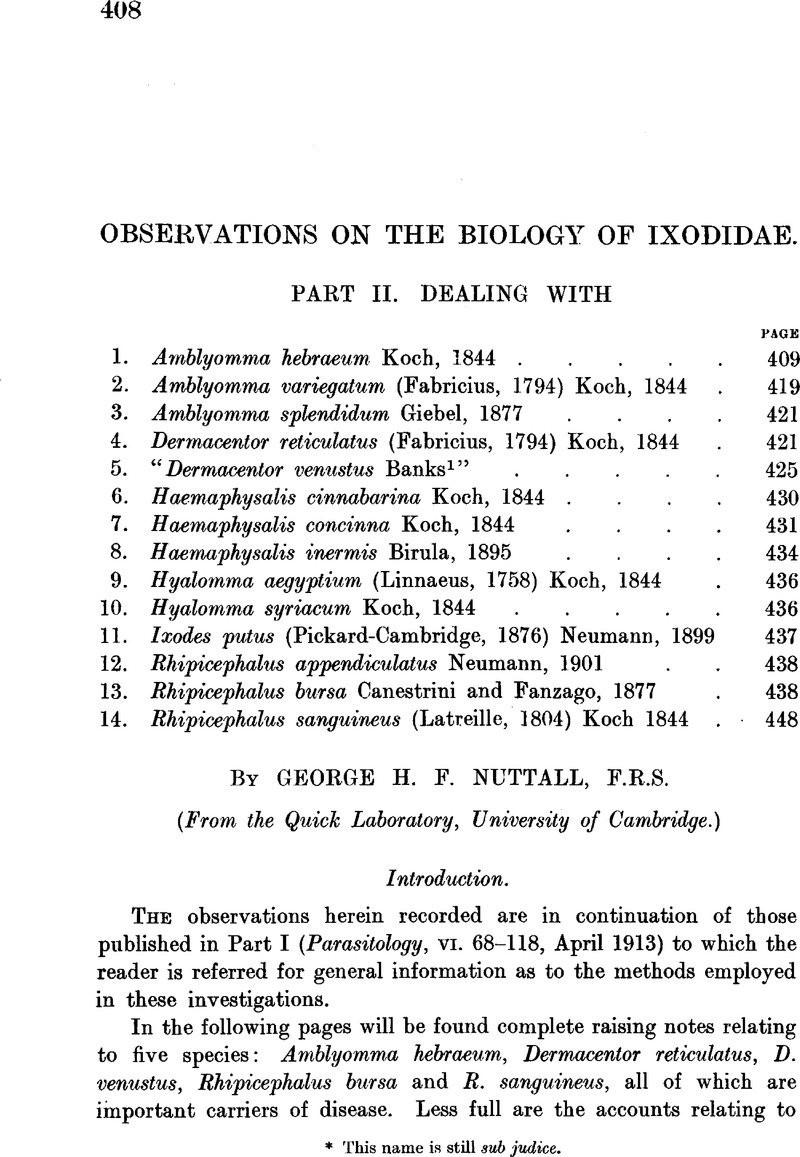Crossref Citations
This article has been cited by the following publications. This list is generated based on data provided by
Crossref.
Daubney, R.
1930.
Natural Transmission of Heart-water of Sheep by Amblyomma variegatum (Fabricius 1794).
Parasitology,
Vol. 22,
Issue. 2,
p.
260.
Lewis, E. Aneurin
1932.
Some Tick Investigations in Kenya Colony.
Parasitology,
Vol. 24,
Issue. 2,
p.
175.
Wilson, S. G.
1950.
A Check-list and Host-list of Ixodoidea found in Nyasaland, with Descriptions and biological Notes on some of the Rhipicephalids.
Bulletin of Entomological Research,
Vol. 41,
Issue. 2,
p.
415.
Feldman-Muhsam, B.
1951.
On the longevity of fasting ticks, Hyalomma savignyi Gerv.
Parasitology,
Vol. 41,
Issue. 1-2,
p.
63.
Gothe, R.
and
Hamel, H. D.
1973.
Zur �kologie eines deutschen Stammes von Rhipicephalus sanguineus (Latreille, 1806).
Zeitschrift f�r Parasitenkunde,
Vol. 41,
Issue. 2,
p.
157.
Wysoki, M.
and
Bolland, H. R.
1979.
Timing of spermatogenesis, chromosomes and sex determination of Amblyomma variegatum and A. Lepidum (Acari: Ixodidae).
Genetica,
Vol. 50,
Issue. 1,
p.
73.
Yonow, Tania
1995.
The life-cycle of Amblyomma variegatum (Acari: Ixodidae): a literature synthesis with a view to modelling.
International Journal for Parasitology,
Vol. 25,
Issue. 9,
p.
1023.
Yeruham, I.
Hadani, A.
Galker, F.
and
Rosen, S.
1996.
The seasonal occurrence of ticks (Acari: Ixodidae) on sheep and in the field in the Judean area of Israel.
Experimental & Applied Acarology,
Vol. 20,
Issue. 1,
p.
47.
Labruna, M.B.
Pinter, A.
Roncati, N.V.
Pereira, M.C.
and
Faccini, J.L.H.
2001.
Exotic ticks on horses imported from Portugal to Brazil.
Arquivo Brasileiro de Medicina Veterinária e Zootecnia,
Vol. 53,
Issue. 2,
p.
1.
Dantas-Torres, Filipe
2008.
The brown dog tick, Rhipicephalus sanguineus (Latreille, 1806) (Acari: Ixodidae): From taxonomy to control.
Veterinary Parasitology,
Vol. 152,
Issue. 3-4,
p.
173.
Dantas-Torres, Filipe
Giannelli, Alessio
Figueredo, Luciana Aguiar
and
Otranto, Domenico
2010.
Effects of prolonged exposure to low temperature on eggs of the brown dog tick, Rhipicephalus sanguineus (Latreille, 1806) (Acari: Ixodidae).
Veterinary Parasitology,
Vol. 171,
Issue. 3-4,
p.
327.
DANTAS-TORRES, FILIPE
FIGUEREDO, LUCIANA A.
and
OTRANTO, DOMENICO
2011.
Seasonal variation in the effect of climate on the biology of Rhipicephalus sanguineus in southern Europe.
Parasitology,
Vol. 138,
Issue. 4,
p.
527.
Dantas-Torres, Filipe
and
Otranto, Domenico
2011.
Rhipicephalus sanguineus on dogs: relationships between attachment sites and tick developmental stages.
Experimental and Applied Acarology,
Vol. 53,
Issue. 4,
p.
389.
Dantas-Torres, Filipe
and
Otranto, Domenico
2011.
Effects of aggregation on the reproductive biology of Rhipicephalus sanguineus females.
Experimental and Applied Acarology,
Vol. 55,
Issue. 4,
p.
417.
Dantas-Torres, Filipe
Giannelli, Alessio
and
Otranto, Domenico
2012.
Starvation and overwinter do not affect the reproductive fitness of Rhipicephalus sanguineus.
Veterinary Parasitology,
Vol. 185,
Issue. 2-4,
p.
260.
Bandaranayaka, K. O.
Apanaskevich, D. A.
and
Rajakaruna, R. S.
2016.
Life cycle of Amblyomma integrum (Acari: Ixodidae) under laboratory conditions.
Experimental and Applied Acarology,
Vol. 69,
Issue. 3,
p.
335.
Bandaranayaka, K. O.
Apanaskevich, D. A.
and
Rajakaruna, R. S.
2016.
Life cycle of Nosomma monstrosum (Acari: Ixodidae) under laboratory conditions.
Experimental and Applied Acarology,
Vol. 69,
Issue. 1,
p.
97.
Huber, K.
Jacquet, S.
Rivallan, R.
Adakal, H.
Vachiery, N.
Risterucci, A.M.
and
Chevillon, C.
2019.
Low effective population sizes in Amblyomma variegatum, the tropical bont tick.
Ticks and Tick-borne Diseases,
Vol. 10,
Issue. 1,
p.
93.





